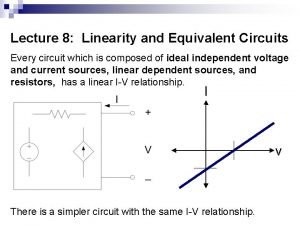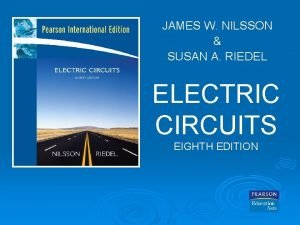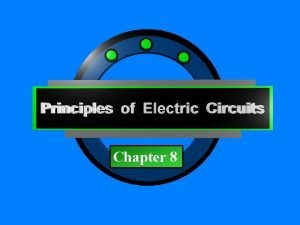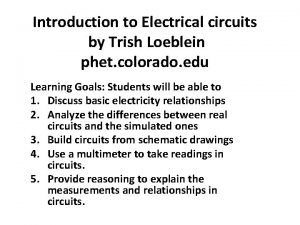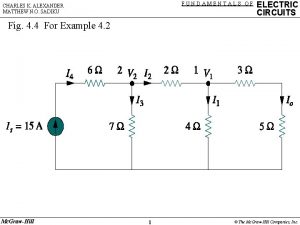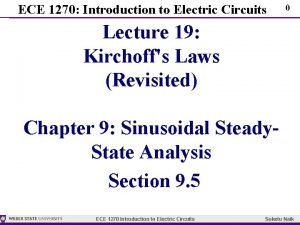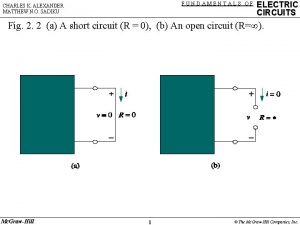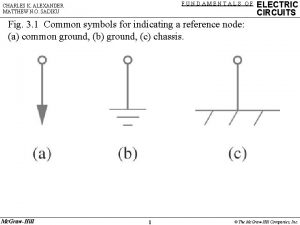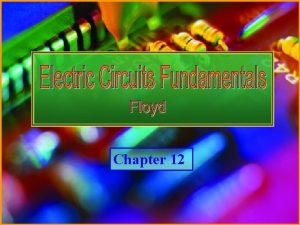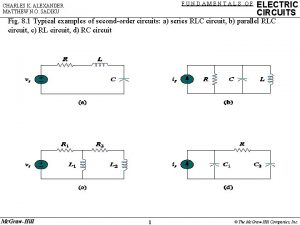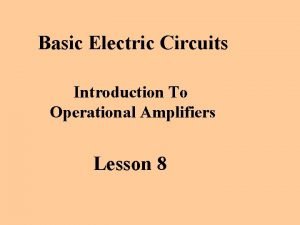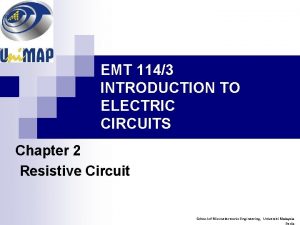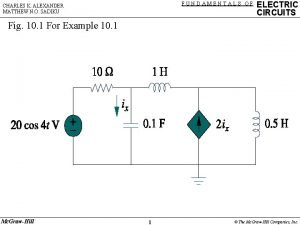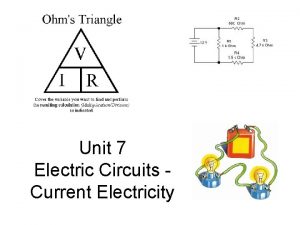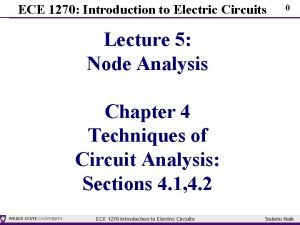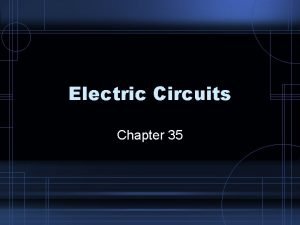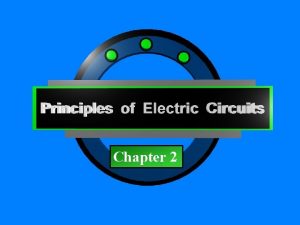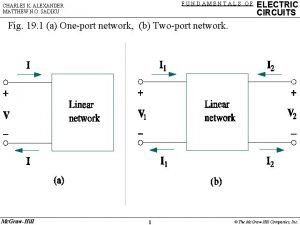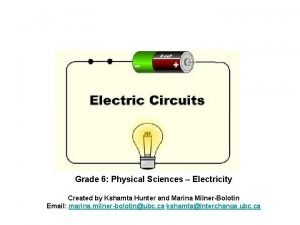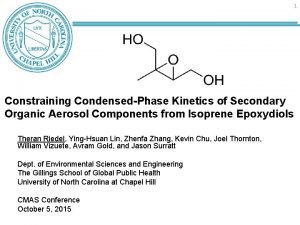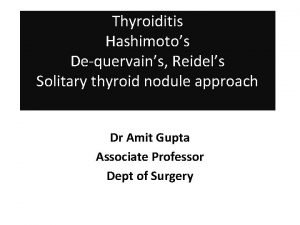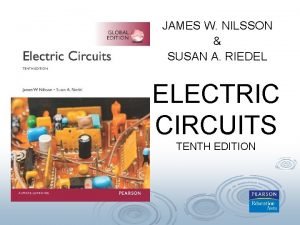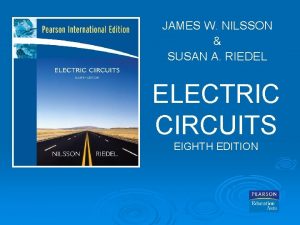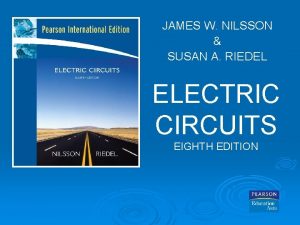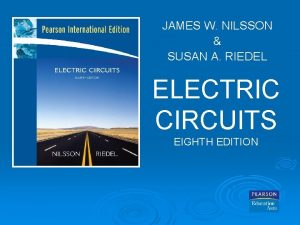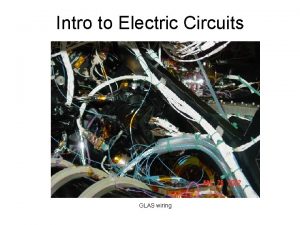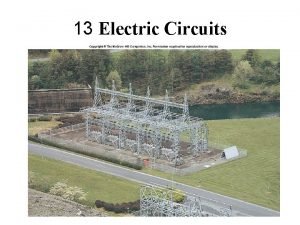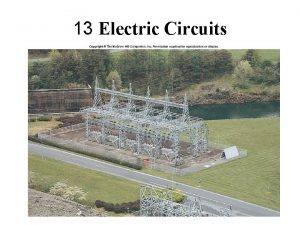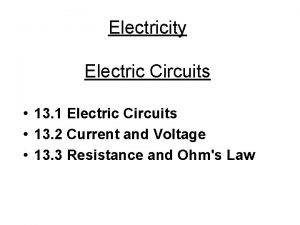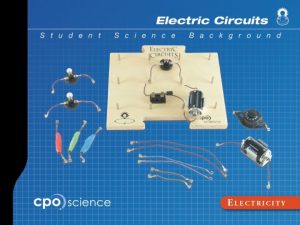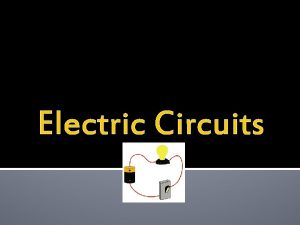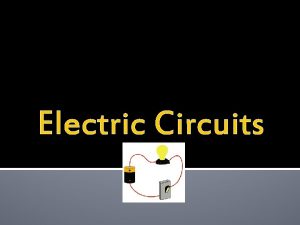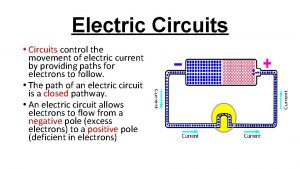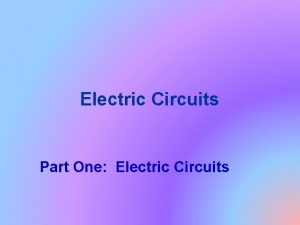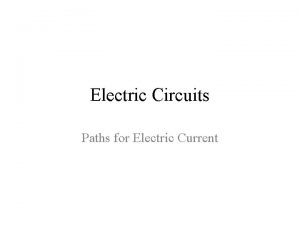JAMES W NILSSON SUSAN A RIEDEL ELECTRIC CIRCUITS



































- Slides: 35

JAMES W. NILSSON & SUSAN A. RIEDEL ELECTRIC CIRCUITS EIGHTH EDITION

CHAPTER 15 ACTIVE FILTER CIRCUITS © 2008 Pearson Education

CONTENTS 15. 1 First-Order Low-Pass and High-Pass Filters 15. 2 Scaling 15. 3 Op Amp Bandpass and Bandreject Filters 15. 4 High Order Op Amp Filters 15. 5 Narrowband Bandpass and Bandreject Filters © 2008 Pearson Education

15. 1 First-Order Low-Pass and High-Pass Filters Ø Active filters consist of op amps, resistors, and capacitors. Ø They can be configured as low-pass, high- pass, bandpass, and bandreject filters. © 2008 Pearson Education

15. 1 First-Order Low-Pass and High-Pass Filters Ø They overcome many of the disadvantages associated with passive filters. © 2008 Pearson Education

15. 1 First-Order Low-Pass and High-Pass Filters A first-order low-pass filter © 2008 Pearson Education

15. 1 First-Order Low-Pass and High-Pass Filters A general op amp circuit © 2008 Pearson Education

15. 1 First-Order Low-Pass and High-Pass Filters A first-order high-pass filter © 2008 Pearson Education

15. 1 First-Order Low-Pass and High-Pass Filters ØA prototype low-pass filter has component values of R 1 = R 2 = 1Ω and C = 1 F, and it produces a unity passband gain and a cutoff frequency of 1 rad/s. © 2008 Pearson Education

15. 1 First-Order Low-Pass and High-Pass Filters ØThe prototype high-pass filter has same component values and also produces a unity passband gain and a cut-off frequency of 1 rad/s. © 2008 Pearson Education

15. 2 Scaling Ø Magnitude scaling can be used to alter component values without changing the frequency response of a circuit. © 2008 Pearson Education

15. 2 Scaling Ø For a magnitude scale factor of km, the scaled (primed) values of resistance, capacitance, and inductance are © 2008 Pearson Education

15. 2 Scaling Ø Frequency scaling can be used to shift the frequency response of a circuit to another frequency region without changing the overall shape of the frequency response. © 2008 Pearson Education

15. 2 Scaling For a frequency scale factor of kf , the scaled (primed) values of resistance, capacitance, and inductance are © 2008 Pearson Education

15. 2 Scaling Ø Components can be scaled in both magnitude and frequency, with the scaled (primed) component values given by © 2008 Pearson Education

15. 2 Scaling Ø The design of active low-pass and high- pass filters can begin with a prototype filter circuit. Ø Scaling can then be applied to shift the frequency response to the desired cutoff frequency, using component values that are commercially available. © 2008 Pearson Education

15. 3 Op Amp Bandpass and Bandreject Filters Constructing the Bode magnitude plot of a bandpass filter © 2008 Pearson Education

15. 3 Op Amp Bandpass and Bandreject Filters A cascaded op amp bandpass filter (a) The block diagram (b) The circuit © 2008 Pearson Education

15. 3 Op Amp Bandpass and Bandreject Filters Ø An active broadbandpass filter can be constructed using a cascade of a lowpass filter with the bandpass filter’s upper cutoff frequency, a high-pass filter with the bandpass filter’s lower cutoff frequency, and (optionally) an inverting amplifier gain stage to achieve nonunity gain in the passband. © 2008 Pearson Education

15. 3 Op Amp Bandpass and Bandreject Filters Ø Bandpass filters implemented in this fashion must be broadband filters (ω ( c 2 » ωc 1), so that the elements of the cascade can be specified independently of one another. © 2008 Pearson Education

15. 3 Op Amp Bandpass and Bandreject Filters Example: Designing a Broadband Bandpass Op Amp Filter. Ø Design a bandpass filter for a graphic equalizer to provide an amplification of 2 within the band of frequencies between 100 and 10, 000 Hz. Use 0. 2µF capacitors. © 2008 Pearson Education

15. 3 Op Amp Bandpass and Bandreject Filters Constructing the Bode magnitude plot of a bandreject filter © 2008 Pearson Education

15. 3 Op Amp Bandpass and Bandreject Filters Ø An active broadbandreject filter can be constructed using a parallel combination of a low-pass filter with the bandreject filter’s lower cutoff frequency and a high-pass filter with the bandreject filter’s upper cutoff frequency. © 2008 Pearson Education

15. 3 Op Amp Bandpass and Bandreject Filters Ø The outputs are then fed into a summing amplifier, which can produce nonunity gain in the passband. Ø Bandreject filters implemented in this way must be broadband filters (ω ( c 2 » ωc 1), so that the low-pass and high-pass filter circuits can be designed independently of one another. © 2008 Pearson Education

15. 3 Op Amp Bandpass and Bandreject Filters A parallel op amp bandreject filter (a) The block diagram (b) The circuit © 2008 Pearson Education

15. 4 Higher Order Op Amp Filters The bode magnitude plot of a cascade of identical prototype first-order filters © 2008 Pearson Education

15. 4 Higher Order Op Amp Filters Ø Higher order active filters have multiple poles in their transfer functions, resulting in a sharper transition from the passband to the stopband thus a more nearly ideal frequency response. © 2008 Pearson Education

15. 4 Higher Order Op Amp Filters A cascade of identical unity-gain low-pass filters. (a) The block diagram (b) The circuit © 2008 Pearson Education

15. 4 Higher Order Op Amp Filters Ø The transfer function of an nth–order Butterworth low-pass filter with a cutoff frequency of 1 rad/s can be determined from the equation: © 2008 Pearson Education

15. 4 Higher Order Op Amp Filters By ØFinding the roots of the denominator polynomial. ØAssigning the left-half plane roots to H(s). ØWriting the denominator of H(s) as a product of first- and second- order factors. © 2008 Pearson Education

15. 4 Higher Order Op Amp Filters Defining the transition region for a low-pass filter © 2008 Pearson Education

15. 5 Narrowband Bandpass and Bandreject Filters An active high-Q bandpass filter © 2008 Pearson Education

15. 5 Narrowband Bandpass and Bandreject Filters A high-Q active bandreject filter © 2008 Pearson Education

15. 5 Narrowband Bandpass and Bandreject Filters ØIf a high-Q, or narrowband, bandpass, or bandreject filter is needed, the cascade or parallel combination will not work. Instead, the circuits shown previously are used with the appropriate design equations. © 2008 Pearson Education

THE END © 2008 Pearson Education
 James w nilsson
James w nilsson Nilsson riedel
Nilsson riedel James w nilsson
James w nilsson Advantages of parallel circuits over series circuit
Advantages of parallel circuits over series circuit Fundamentals of electric circuits chapter 7 solutions
Fundamentals of electric circuits chapter 7 solutions Principles of electric circuits 10th edition answer key
Principles of electric circuits 10th edition answer key Phet build a circuit
Phet build a circuit Charles k. alexander matthew n. o. sadiku
Charles k. alexander matthew n. o. sadiku Chapter 20 electric circuits
Chapter 20 electric circuits Introduction to electric circuits
Introduction to electric circuits Fundamentals of electric circuits
Fundamentals of electric circuits Alexander
Alexander Chapter 35 electric circuits answers
Chapter 35 electric circuits answers Electric circuits fundamentals floyd
Electric circuits fundamentals floyd Fundamentals of electric circuits chapter 4 solutions
Fundamentals of electric circuits chapter 4 solutions Fundamentals of electric circuits
Fundamentals of electric circuits Electric circuits equations
Electric circuits equations Ise fundamentals of electric circuits
Ise fundamentals of electric circuits Introduction to electric circuits
Introduction to electric circuits Alexander
Alexander Circuits-current worksheet answers
Circuits-current worksheet answers Physics reference table
Physics reference table Chapter 20 electric circuits
Chapter 20 electric circuits Superposition electric circuits
Superposition electric circuits Introduction to electric circuits
Introduction to electric circuits Fundamentals of electric circuits chapter 9 solutions
Fundamentals of electric circuits chapter 9 solutions Basic electrical engineering kulshreshtha
Basic electrical engineering kulshreshtha Chapter 35 electric circuits
Chapter 35 electric circuits What three elements are required for all electric circuits
What three elements are required for all electric circuits Principles of electric circuits
Principles of electric circuits Sadiku
Sadiku Conceptual physics chapter 35
Conceptual physics chapter 35 Electric circuits grade 6
Electric circuits grade 6 Theran riedel
Theran riedel Riedel's thyroiditis
Riedel's thyroiditis Riedel frota
Riedel frota

